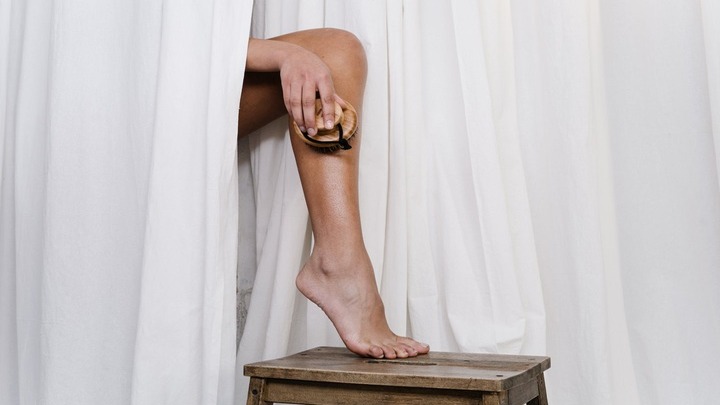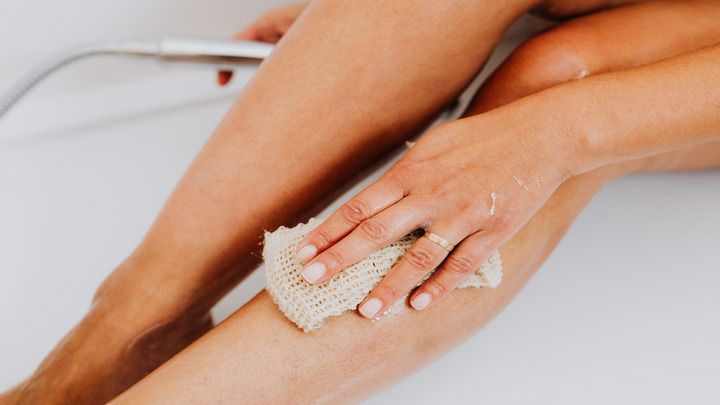If you want to exfoliate, your legs are one of the most sensitive parts you should pay attention to.
If you are wondering why this is important, well, it’s because the legs are the most exposed part of the body. Not only that, they have ingrown hairs often exposed and toughened, making it harder to smoothen the pores of the skin or remove dirt and grime.
That’s why you need to learn how to exfoliate your legs properly if you want a smooth, bright texture all the time.
This article will walk you through the process of exfoliating your legs using different methods and exfoliants.
Why do you need to exfoliate legs?
1. Brightens the skin
Exfoliating is known to remove dead skin cells that are still lodged on the skin’s surface. These dead skin have a hard, dull texture. However, when sloughed off, they reveal newer skin that is bright and clear of blemishes.
You need to keep your skin looking radiant, and the best way to do this is to exfoliate.
2. Softens skin
Exfoliating helps to soften your skin, leaving smooth newer skin. When you exfoliate, you remove dead, dry skin, which blocks new softer skin from appearing.
3. Treats skin issues
Exfoliating helps prevent skin issues like ingrown hairs, scaly skin, or sunburn skin. Exfoliation is a healthy way to curb these skin issues because no debris or oil is blocking the skin.
How to exfoliate legs
1. Scrubs
Scrubs are the best agents to use to exfoliate your skin. The product contains large granules that peel off dead skin cells through soft abrasive contact.
These granules are sugar, salts, or other particles of various sizes that can rub the skin.
To use:
- Wet your legs.
- Apply the scrub to your legs.
- Gently rub in a circular motion to remove dead skin.
- Rinse off after rubbing.
- Dry, then moisturize your skin.
2. Chemical exfoliants
These are chemicals or acids that slough off dead skin by removing the glue attaching the dead skin cells to the skin. This method is less abrasive and easily removes dead skin.
Common chemical exfoliants include alpha hydroxy acids (AHAs) like glycolic and lactic acids. Then there are BHAs (beta hydroxy acids) like salicylic acid.
These acids are easy to use on the skin. You simply apply it with your hands or a cotton ball. You can either wash it off or leave it on the skin, depending on the product’s guide.
3. Exfoliating miff
You can choose exfoliating miff if you have tough, dry skin. This is also a mechanical exfoliant used in removing dead skin.
All You need to do is scrub your dry legs with the miffs (dry brushing) and wash your skin with water.
You can also use body wash or soap lather as lubricants to prevent friction when scrubbing with the miff or loofah.
Note: Use a loofah or towel if you have sensitive skin.
How to exfoliate legs before shaving
Exfoliating before shaving opens your pores, then removes dirt and grime clogging them. Doing this will get the hair follicles removed deep within when shaving. It also prevents ingrown hairs stuck in the pores.
You can use any method you want, depending on your skin type. If you have dry skin, choose chemical exfoliants. Sensitive skin should also use chemical exfoliants. Meanwhile, oily and acne-prone skin should seek the help of scrubs to remove tough dead skin cells and excess sebum.
To exfoliate:
- Wet your skin.
- Apply your exfoliant, then massage your legs.
- Rinse off the exfoliant with lukewarm water.
- Pat dry, then apply shaving cream.
How to exfoliate legs after a wax
If you just got a wax and want to know when to scrub off residue and dead skin on your skin, do it at least two days after your wax. This prevents skin irritation and redness.
Additionally, use soft exfoliating tools like a loofah or washcloth instead of a hard exfoliating miff.
To exfoliate legs after waxing:
- Lather up your legs with a body wash or mild soap.
- Gently scrub your legs with a loofah in a circular motion.
- Cover the entire area of your legs, especially behind.
- Rinse off the remaining lather with lukewarm water.
How to exfoliate legs without scrub
Loofah or washcloth
A loofah or washcloth are great alternatives if you want to exfoliate without a scrub. Rubbing your skin with a mildly rough tool will get the dead skin cells off your skin, as explained.
You can use a plain body wash or warm water to work on your skin. Additionally, you can try dry brushing before starting your bath routine.
Body peels
AHAs and BHAs are excellent exfoliants that remove dead skin cells without abrasive contact. Stick to classics like salicylic acid, lactic acid, and glycolic acid to exfoliate. They also help to soften and unclog the skin pores.
Honey
Honey contains antibacterial and antimicrobial properties that help to cleanse the skin. This includes peeling off skin cells. It is a natural exfoliant that sticks to the skin and peels off. Furthermore, honey contains gluconic acid (a form of AHA) that cleanses and lightens the skin.
DIY scrubs to exfoliate legs
1. Epsom salt scrub
Epsom salt has a coarse texture that helps remove dead skin on contact. The salt is known to help improve circulation too.
To use:
- Mix equal parts of Epsom salt and any oil of your choice (coconut, jojoba, or argan oil preferably).
- Apply the mixture to your wet legs.
- Rub in a circular motion and rinse off with water.
2. Honey and sugar scrub
Honey is a natural exfoliant. It contains antimicrobial and antibacterial properties, which are beneficial to the skin. Combined with sugar granules, it exfoliates and moisturizes the skin.
To use:
- Mix 1/2 cup of sugar (brown or white) with 2 tablespoons of honey.
- Add a teaspoon of coconut oil.
- Apply the mixture to your legs and rub in circular motions.
- Rinse off the residue on your skin.
Note: Exfoliate in the shower to prevent a sticky mess.
3. Sugar and coconut oil scrub
Sugar (especially brown) is a great ingredient used in scrubs. It’s convenient to use and mix with other natural ingredients. The best combination for homemade scrub is sugar and coconut oil.
To use:
- Mix 1/2 cup of brown sugar with 2 tablespoons of coconut oil.
- Apply on your legs and rub in a circular motion.
- Rinse thoroughly.
4. Baking soda and lemon
Baking soda and lemon are natural exfoliants sitting somewhere in your home too. The solution may be a bit harsh on the skin because of the acids they contain. So do not use it if you get irritated or inflamed easily.
To use:
- Mix 1/2 cup of baking soda with 1/2 cup of lemon juice to form a thick paste.
- Rub in a circular motion on your legs.
- Rinse off with water.
FAQs

How often should you exfoliate your legs?
Twice a week.
Spacing your exfoliating sessions with days would help prevent inflamed or irritated skin, especially for dry and sensitive skin. However, oily skins may have to do theirs more frequently because excess sebum builds faster.
Will exfoliating lighten your skin?
Yes, it would.
Dead skin cells are known to make the skin dull. Therefore, exfoliating would help to lighten the skin by removing the dead cells to reveal newer, clearer skin.
Additionally, when you exfoliate, you are removing irregular pigmentation and blemishes in the skin. This is the first step in getting a lighter skin complexion.
Can you exfoliate legs with eczema?
Yes, you can.
Exfoliating legs riddled with eczema would prevent flare-ups and clear accumulated dead skin. Furthermore, exfoliating gets rid of bacteria and excess oil that could worsen eczema on the skin.
Conclusion
When you want to exfoliate your legs, you have to pick either a mechanical or chemical exfoliant, depending on your skin type. You can also choose to make DIY exfoliants from things sitting somewhere in your home.
Then, work on your legs to remove dead cells and enhance your skin’s soft and smooth texture; don’t forget to moisturize.
Exfoliating your legs would ensure you keep smooth, even skin all the time. I recommend following this guide on how to exfoliate legs to improve your skin health.
Thanks for reading.
Get more beauty and skincare tips here on MBGON.
